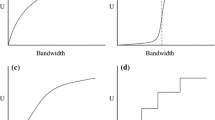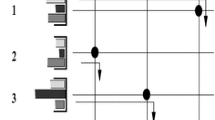Abstract
Most of the solutions proposed to support real-time (i.e., guaranteed performance) communication services in packet-switching networks adopt a connection-oriented and reservation-oriented approach. In such an approach, resource allocation and route-selection decisions are made before the start of the communication on the basis of resource availability and real-time network load at that time, and are usually kept for the duration of the communication. This ratherstatic resource-management approach has certain limitations. It does not take into account (a) the dynamics of the communicating clients; (b) the dynamics of the network state; and (c) the tradeoff between quality of service and network availability, thus affecting theavailability andflexibility of the real-time network services. Availability is the ability of the network to accommodate as many real-time clients as possible, while flexibility is the ability to adapt the real-time services to the changing state of the network and the client demands. In this paper, we present the dynamic connection management (DCM) scheme, which addresses these issues by providing the network with the capability of dynamically modifying the performance parameters and the routes of any existing real-time connection. With this capability, DCM can be used to increase the availability and flexibility of the guaranteed-performance service offered to the clients.
Similar content being viewed by others
References
Anderson DP, Herrtwich RG, Schaefer C (1990) SRP: a resource reservation protocol for guaranteed performance communication in the Internet. Technical Report TR-90-006, International Computer Science Institute, Berkeley, Calif.
Bellman R (1958) On a routing problem. Quarterly of Applied Mathematics 16:87–90
Cidon I, Gopal I, Guerin R (1991) Bandwidth management and congestion control in PlaNET. IEEE Commun Magazine 20(10):54–64
Clark D, Shenker S, Zhang L (1992) Supporting real-time applications in an integrated services packet network: architecture and mechanism. Proc SIGCOMM'92, pp 14–26
Cocchi R, Estrin D, Shenker S, Zhang L (1991) A study of priority pricing in multiple service class networks. Proc SIGCOMM'91, pp 123–130
Darragh DC, Baker RL (1989) Fixed distortion subband coding of images for packet-switched networks. IEEE J Selected Areas Commun 7: 826–832
Delgrossi L, Halstrick C, Hehmann D, Herrtwich RG, Krone O, Sandvoss J, Vogt C (1993) Media scaling for audiovisual communication with HeitS. Proc ACM Multimedia '93, pp 99–104
Ferrari D (1990) Client requirements for real-time communication services. IEEE Commun Magazine 28(11):65–72
Ferrari D (1992) Real-time communication in an internetwork. J High Speed Networks, 1:79–103
Ferrari D, Verma D (1990) A scheme for real-time channel establishment in wide-area networks. IEEE J Selected Areas Commun 8:368–379
Ferrari D, Banerjea A, Zhang H (1992) Network support for multimedia: a discussion of the Tenet approach. Technical Report TR-92-072, International Computer Science Institute, Berkeley, California, (also to appear in Computer Networks and ISDN Systems, 1994)
Ghanbari M (1989) Two-layer coding of video signals for VBR networks. IEEE J Selected Areas Commun 7:771–781
Gilge M, Gusella R (1991) Motion video coding for packet switching networks — an integrated approach. SPIE Visual Commun Image Processing '91 1605:592–603
Karlsson G, Vetterli M (1988) Subband coding of video for packet networks. Optical Engineering 27:574–586
Lazar A, Paciflci G (1991) Control of resources in broadband networks with quality of service guarantees. IEEE Commun Magazine 29(10):66–73
Parris C, Keshav S, Ferrari D (1992a) A framework for the study of pricing in integrated networks. Technical Report TR-92-016, International Computer Science Institute, Berkeley, Calif.
Paris C, Zhang H, Ferrari D (1992b) A mechanism for dynamic re-route of real-time channels. Technical Report TR-92-053, International Computer Science Institute, Berkeley, Calif.
Parris C, Ventre G, Zhang H (1993) Graceful adaptation of guaranteed performance service connections. Proc IEEE GLOBECOM'93, Houston, Tex., pp 1770–1776
Parulkar GM, Turner S (1989) Towards a framework for high speed communications in a heterogeneous networking environment. Proc INFOCOM'89, pp 655–668, Ottawa
Sheng S, Chandrakasan A, Brodersen RW (1992) A portable multimedia terminal. IEEE Commun Magazine 30(12):64–75
Michael Stonebraker (1992) An overview of the Sequoia 2000 project. Proc COMPCOM 92, San Francisco, Calif.
Teraoka F, Yokote Y, Tokoro M (1991) A network architecture providing host migration transparency. Proc SIGCOMM'92, pp 209–220
Tokuda T, Chou STC, Moura JMF (1992) QoS control in ARTS/FDDI continuous media communications. Proc SIG-COMM '92, pp 88–98
Topolcic C (1990) Experimental internet stream protocol, version 2 (ST-II) Internet Engineering Task Force Request for Comments 1190
Verma D, Zhang H, Ferrari D (1991) Guaranteeing delay jitter bounds in packet switching networks. ProcTricomm'91, Chapel Hill, N.C., pp 35–46
Yin N, Hluchyi MG (1991) A dynamic rate control mechanism for integrated networks. Proc INFOCOM'91, pp 543–552
Vogt C, Herrtwich R, Nagarajan R (1992) HeiRAT — The Heidelberg Resource and Administration Technique: Design Philosophy and Goals. Technical Report No. 43.9213, IBM Technical Report, IBM ENC, Heidelberg, Germany
Zhang H, Ferrari D (1993) Rate-ntrolled static priority queueing. Proc IEEE INFOCOM'93, pp 227–236, San Francisco, Calif.
Zhang H (1993) Service disciplines for integrated services packet-switchin networks. PhD dissertation, University of California at Berkeley, Berkeley, CA
Zhang H, Keshav S (1991) Comparison of rate-based service disciplines. Proc ACM SIGCOMM '91, pp 113–122, Zurich, Switzerland
Zhang L (1989) A new architecture for packet switched network protocols. PhD dissertation, Massachusetts Institute of Technology, Cambridge, MA
Author information
Authors and Affiliations
Corresponding author
Rights and permissions
About this article
Cite this article
Parris, C., Zhang, H. & Ferrari, D. Dynamic management of guaranteed-performance multimedia connections. Multimedia Systems 1, 267–283 (1994). https://doi.org/10.1007/BF01223348
Issue Date:
DOI: https://doi.org/10.1007/BF01223348




